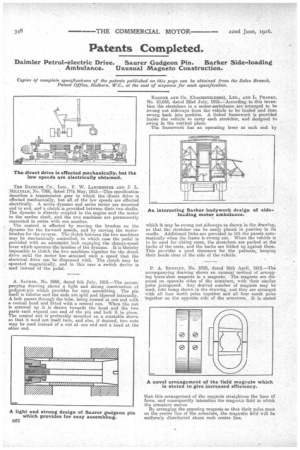Patents Completed.
Page 24

If you've noticed an error in this article please click here to report it so we can fix it.
Daimler Petra-electric Drive. Saurer Gudgeon Pin. Barker Side-loading Ambulance. Unusual Magneto Construction.
Copies of complete specifications of the patents published on this page can be obtained from the Sales Branch, Patent Office, Holborn, W.C., at the cost of sixpence for each specification.
TILE DAIMLER CO., LTD., F. W. LANOHESTER AND J. L. ItImarc...aN, No. 7366, dated 17th May, 1915.—This specification describes a transmission gear in which the direct drive is effected mechanically, but all of the low speeds are effected electrically. A series dynamo and series motor are mounted end to end, and a clutch is provided between their two shafts. The dynamo is directly coupled to the engine and the motor to the cardan shaft, and the two machines are permanently connected in series with one another.
The control is effected by moving the brushes on the dynamo for the forward speeds, and by moving the motor brushes for the reverse. The clutch between the two machines may be mechanically controlled, in which case the pedal is provided with an automatic lock engaging the change-speed lever which operates the brushes of the dynamo. It is thereby impossible to clutch the two machines together for the direct drive until the motor has attained such a speed that the electrical drive can be dispensed with. The clutch may be operated magnetically, and in this case a switch device is used instead of the pedal.
A. Saurcatt, No. 9860, dated 6th July, 1915.—The accompanying drawing shows a light and strong construction of gudgeon-pin which provides for easy assembling. The pin itself is tubular and the ends are split and tapered internally,. A bolt passes through the tube, being formed at one end with a conical head and fitted with a conical nut. When the nut is screwed up it is drawn towards the head and the two parts each expand. one end of the pin and lock it in place. The conical nut is preferably mounted on a rotatable sleeve so that it need not itself turn, and also, if desired, two nuts may be used instead of a nut at one end and a head at the other end.
BARRER AND CO. (COACHBITILDERS), LTD., AND L. Protatacs, No. 10,655, dated 22nd July, 1915.—According to this invention the stretchers in a motor-ambulance are arranged to be swung out sideways from the vehicle to be loaded and then swung back into position. A linked framework is provided inside the vehicle to carry each stretcher, and designed to swing in the vertical plane. The framework has an operating lever at each end by which it may be swung out sideways as shown in the drawing, so that the stretcher can be easily placed in position in its cradle. Additional links are provided to lift the panels automatically when the frame is swung out. When the vehicle is to be used for sitting cases, the stretchers are packed at the backs of the seats, and the backs are folded up against them. This provides a good clearance for the patients, keeping their heads clear of the side of the vehicle.
P. A. BENTLEY, No. 5723, dated 16th April, 1915.—The accompanying drawing shows an unusual method of arranging horse-shoe magnets in a magneto. The magnets are disposed on opposite sides of the armature, with their similar poles juxtaposed. Any desired number of magnets may be used, fear being shown in the drawing, and they are arranged with all four north poles together and all four south poles together on the opposite side of the armature. It is stated that this arrangement of the magnets straightens the lines of force, and consequently intensifies the magnetic field in which the armature moves.
By arranging the opposing magnets so that their poles meet on the centre line of the armature, the magnetic field will be uniformly distributed about such centre line.
























